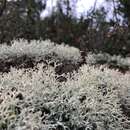Biology
provided by Arkive
Lichens consist of two different organisms, a fungus and either an alga (a simple plant) or a cyanobacterium (bacteria that can photosynthesise), which live together symbiotically, forming a composite organism (3). Many lichens are known to be very sensitive to environmental pollution, and they have been used as 'indicators' species (3). There has been some doubt about the taxonomic status of this species in the UK it was thought that at some sites, the species present may be a form of C. portentosa (1). However, recent genetic analysis by the Natural History Museum on behalf of Plantlife, the wild plant charity, has shown that this species does indeed occur on the Lizard peninsula (5).
Conservation
provided by Arkive
The sites on Lizard Peninsula occur in a National Nature Reserve (1). Cladonia mediterranea is a UK Biodiversity Action Plan Priority Species. The Species Action Plan aims to maintain and where possible, enhance all current populations. Work is needed to elucidate the taxonomic status of the species in the UK (1).
Description
provided by Arkive
This member of the Cladonia (reindeer lichen) genus is whitish-grey in colour (2) and grows in low (1), bushy clumps (2). The familiar common name of these lichens, 'reindeer moss' is a misnomer, as the species is a lichen. This name arose because many members of the Cladonia genus comprise a major part of the diet of reindeer during winter (3), but this species, which as the specific name mediterranea suggests, does not occur in areas supporting reindeer (5).
Habitat
provided by Arkive
Reindeer lichen occurs on alkaline soils (pH 7.0-7.3), usually amongst open vegetation (1). In all UK sites it is found growing with heather (Calluna vulgaris) (2). in Pembrokeshire it is found on boulder scree, and on Lizard it occurs on a bank supporting serpentine heath (2).
Range
provided by Arkive
In the UK it occurs on Lizard Peninsula in Cornwall, and an unverified record was made from Carn Ingli in Pembrokeshire, although it has not been found there again (5). Elsewhere, it is known from the Mediterranean area, Turkey, western parts of France, North Africa and the Canary Isles (2).
Status
provided by Arkive
Classified as Critically Endangered in Great Britain, and receives general protection under the Wildlife and Countryside Act 1981.
Threats
provided by Arkive
The remaining populations of this lichen in the UK are very small; this makes them highly vulnerable (1). Possible threats are trampling by livestock and the public, and fires (2).

